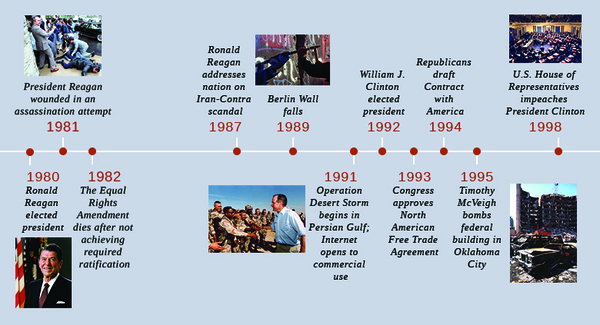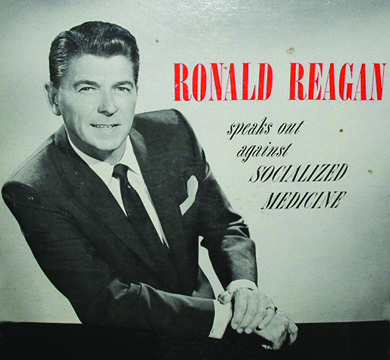| << Chapter < Page | Chapter >> Page > |

Ronald Reagan entered the White House in 1981 with strongly conservative values but experience in moderate politics. He appealed to moderates and conservatives anxious about social change and the seeming loss of American power and influence on the world stage. Leading the so-called Reagan Revolution, he appealed to voters with the promise that the principles of conservatism could halt and revert the social and economic changes of the last generation. Reagan won the White House by citing big government and attempts at social reform as the problem, not the solution. He was able to capture the political capital of an unsettled national mood and, in the process, helped set an agenda and policies that would affect his successors and the political landscape of the nation.
Although many of his movie roles and the persona he created for himself seemed to represent traditional values, Reagan’s rise to the presidency was an unusual transition from pop cultural significance to political success. Born and raised in the Midwest, he moved to California in 1937 to become a Hollywood actor. He also became a reserve officer in the U.S. Army that same year, but when the country entered World War II, he was excluded from active duty overseas because of poor eyesight and spent the war in the army’s First Motion Picture Unit. After the war, he resumed his film career; rose to leadership in the Screen Actors Guild, a Hollywood union; and became a spokesman for General Electric and the host of a television series that the company sponsored. As a young man, he identified politically as a liberal Democrat, but his distaste for communism, along with the influence of the social conservative values of his second wife, actress Nancy Davis, edged him closer to conservative Republicanism ( [link] ). By 1962, he had formally switched political parties, and in 1964, he actively campaigned for the Republican presidential nominee Barry Goldwater.

Reagan launched his own political career in 1966 when he successfully ran for governor of California. His opponent was the incumbent Pat Brown, a liberal Democrat who had already served two terms. Reagan, quite undeservedly, blamed Brown for race riots in California and student protests at the University of California at Berkeley. He criticized the Democratic incumbent’s increases in taxes and state government, and denounced “big government” and the inequities of taxation in favor of free enterprise. As governor, however, he quickly learned that federal and state laws prohibited the elimination of certain programs and that many programs benefited his constituents. He ended up approving the largest budget in the state’s history and approved tax increases on a number of occasions. The contrast between Reagan’s rhetoric and practice made up his political skill: capturing the public mood and catering to it, but compromising when necessary.

Notification Switch
Would you like to follow the 'U.s. history' conversation and receive update notifications?